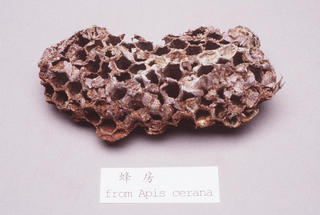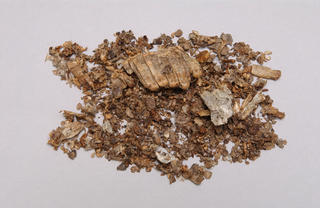Polistes japonicus
Contents
Nomenclature
Other Names:
Historical Use of Polistes japonicus
Polistes japonicus in Traditional Chinese Medicine
Background
Chinese Name (pinyin): Fengfang
Chinese Name :
Common Name :Honeycomb
Specific Name : Nidus vespae
Scientific Name:
Collection : The drug is collected in autumn and winter, dried in the sun or steam brieflly, removed from dead wasps and pupae and dried in the sun.
Description : In disc-shaped or irregular flattened pieces, some nearly lotus receptacle-shaped, varying in size. The surface greyish white or greyish brown. Ventral side with numerous regular hexagonal openings of cells, the openings 3 - 4mm or 6 - 8mm in diameter, dorsal side with 1 or several black short stalks. Light texture tenacious, slightly elastic, odour slight and taste pungent and weak.. The honeycomb of fragile or hard texture should not be use for medicine.
Identification :
Processing : Eliminate foreign matter, cut into pieces.
Action : To dispel wind, to counteract toxicity, to kill parasites, and to relieve itching.
Indication : toothache due to caries; sores; ulcers; mastitis; scrofula; ringworm, tinea unguium
Precautions :
Dosage : 3 to 5 g, to be decocted or scorched; for external use, appropriate quantity to be ground into powder and applied topically after mixing with oil or to be made into decoction for gargling and washing.
Storage : Preserve in a ventilated dry place, protected from pressure and moth.
Synonymns for Polistes japonicus
Patent Medicines and Medicines with Multiple Ingredients that include Polistes japonicus
Pharmaceutical Information
Chemical Constituents
Evidence or the Use of Polistes japonicus in the Treatment of Epilepesy
Basic Science
Animal Studies
Cohort, Case-Control and Non-Randomized Trials
Randomized Controlled Trials
Meta-Analysis
1st Five Results: pubmed search
Yan Zeng, Anna Nikitkova, Hossam Abdelsalam, Jiyao Li, Jin Xiao
Activity of quercetin and kaemferol against Streptococcus mutans biofilm.
Arch Oral Biol: 2019, 98;9-16
[PubMed:30419487]
[WorldCat.org]
[DOI]
(I p)
Fuki Saito, Jun-ichi Kojima, Lien T P Nguyen, Mikiko Kanuka
Polistes formosanus (Hymenoptera: Vespidae), a good species supported by both morphological and molecular phylogenetic analyses, and a key social wasp in understanding the historical biogeography of the Nansei Islands.
Zoolog Sci: 2007, 24(9);927-39
[PubMed:17960999]
[WorldCat.org]
[DOI]
(P p)
Jin Xiao, Yuling Zuo, Yuan Liu, Jiyao Li, Yuqing Hao, Xuedong Zhou
Effects of Nidus Vespae extract and chemical fractions on glucosyltransferases, adherence and biofilm formation of Streptococcus mutans.
Arch Oral Biol: 2007, 52(9);869-75
[PubMed:17382894]
[WorldCat.org]
[DOI]
(P p)
Jin Xiao, Yuan Liu, Yu Ling Zuo, Ji Yao Li, Ling Ye, Xue Dong Zhou
Effects of Nidus Vespae extract and chemical fractions on the growth and acidogenicity of oral microorganisms.
Arch Oral Biol: 2006, 51(9);804-13
[PubMed:16723116]
[WorldCat.org]
[DOI]
(P p)

